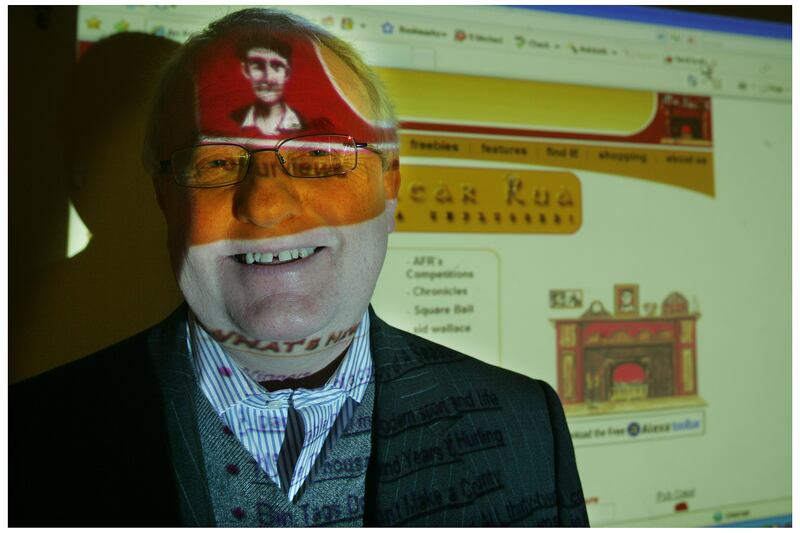It was at a Gaelic Writers Association annual dinner that a colleague, who works across sports remarked that he always enjoyed the occasion because in his experience GAA reporters were the least cliquey of the various groups he came across.
On Monday came news that someone who embodied that collegiality had died. I knew from his son Ian that Tom O’Riordan hadn’t been well but the news still came as a shock.
The very first event I was asked to cover as a freelance reporter was a schools athletics competition — beguilingly sponsored by Silvermints — in Belfield, this week 33 years ago.
[ Tom O’Riordan, an infectious evangelist for athletics, dies aged 84Opens in new window ]
In a neat association with last weekend it was titled, the Tailteann interprovincial schools track and field championships. It appeared to take endless amounts of time, starting at 11am and still going that evening. Having been advised not to make the rookie mistake of arriving at the start, I made my entrance at around 2pm.
There I came across two Kerry men. One was utterly involved in the action, stopwatch around his neck and clicking it on and off and making various comments on the racers. The other was also a freelance, covering the event, older than me and who introduced himself as JJ Barrett, who died last July.
It was infernally hot. UCD’s campus was like a grill, which helped one thing to lead to another.
The task in Belfield wasn’t to write a report on the meeting but simply to gather the results of all the finals — nowadays such stuff would be e-mailed or posted in seconds.
I approached the first Kerry man, who I now knew to be former Olympian and Irish Independent journalist, Tom O’Riordan and tentatively inquired was there time to head off for a while.
Absolutely, he said reassuringly. Come back later and I’ll see you get all the results. In short time, JJ and I were across the road in the Montrose, taking shelter from the blistering afternoon.
He told me about his own playing career and his family and football’s role in healing Civil War divisions in Kerry — which he would some years later turn into a wonderful memoir, ‘In the Name of the Game’.
When the time came, Tom was handing out photocopies of results and briefing on anything noteworthy.
Tom, like all athletes, was apt to go running whenever he had a chance but ask him to walk one step farther than necessary to get to a ground and he would be incredulous
A week later I was at a pub quiz — the 1980s phenomenon which took up absurd amounts of my life — when a picture round included what looked like a distance runner. I was able to tell my table that I’d met him the previous weekend.
Having ended up as a colleague on the GAA beat, I found Tom endlessly accommodating to others.
One late night in Croke Park when the old GAC was taking even longer than usual, he told us all to go home. He’d let us know, he said, if anything happened back in the days when such selflessness didn’t even bestow first mover advantage for online publication.
An intensely proud Ardfert man and passionate — and infinitely hopeful — about Kerry football, he was excellent company if prone to eccentricities. Martin Breheny recalled how Tom, like all athletes, was apt to go running whenever he had a chance but ask him to walk one step farther than necessary to get to a ground and he would be incredulous.
Furtively scanning the horizon for Gardaí, he would shift traffic cones a car’s length down the road and reverse into the shadow of some stadium.
Now that he has parked for the last time, he’ll be missed but well and warmly remembered by all who had the good fortune to know and work with him.

By coincidence I also met Liam Cahill for the first time in 1989 when he was political correspondent with RTE. That was part of a force field of activity in public affairs, journalism, broadcasting, politics and public relations that marked out his career.
In 2000 having left a big job with multinational Intel, he set up An Fear Rua, a website dedicated to the GAA and its games. Alerted to the appeal of Gaelic games online by the Intel intranet that he curated, he decided to pursue the idea.
Liam was a bundle of energy, convinced that he could build it into a commercial proposition but philosophical when that didn’t happen despite his investment of €150,000 over the 12 years of the website’s existence.
His pioneering efforts were largely undermined by a phenomenon familiar from social media these days: an inability for online discussion to remain civil and more important not defamatory.
As he told The Irish Times in 2007, “You watch as much as you can but often it can be the 41st posting on a thread that goes mad after 40 perfectly reasonable ones.”
I got to know him in those years and was one of those who would text him warnings whenever I came across any of the above 41st postings.
He was an avid follower of his native Waterford, a distinguished historian with a great interest in the Labour movement and a tireless trade unionist — someone whose good nature and kindness were summed up by doing his best for those marginalised or wronged.
It’s been a mournful week that has seen the untimely passing of the Tyrone hurlers’ scoring phenomenon Damian Casey as well as former Cavan football captain and Ulster medallist Enda McGowan and Richie Crean, part of Tom Carr’s management when Dublin contested the first All-Ireland quarter-finals in 2001 in a memorable draw and replay with Kerry in Thurles.
All gone but all testament to how Gaelic games captivates, engages and bonds both communities and the most disparate of individual talents.

















